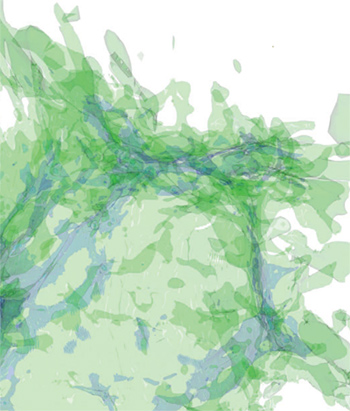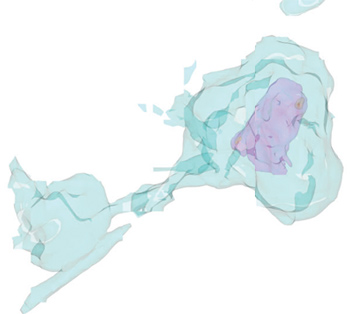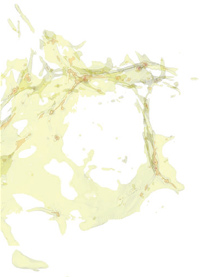The secret lives of stars
by Monica Bobra
| "If you wish to make an apple pie from scratch, you must first invent the universe." Carl Sagan, Cosmos |
 Image software: VisIt, Lawrence Livermore National Laboratory Simulations recreate the supernova process for the first star. The background images represent three possible versions of the first star in the universe, approximately 180 million years after the big bang. Each image stems from a different initial distribution of dark matter. Some ten million years after the big bang, dark matter clumps attracted hydrogen and helium gas, which coalesced to form the star. Each colored layer denotes a surface of constant density in the hydrogen and helium gas. Simulations and images: Matthew Turk, Tom Abel, KIPAC; Brian O'Shea, Los Alamos National Laboratory; Michael L. Norman, University of California, San Diego; Greg Bryan, Columbia University. |
Donning plastic 3D glasses and turning out the lights, a small group of astrophysicists intently watch the universe projected on the wall. Clouds of gas appear to graze their noses; though they're safe within a visualization lab, a simulation takes them over 13 billion years back in time.
Dozens of red and orange potato-shaped shells dance on the wall, wafting together and accreting to create the dense, white core of a star. Each lumpy shell represents a surface of constant density in the hydrogen and helium quagmire a few million years after the birth of the universe. Eventually, the camera pans inward, whizzing through thicker and thicker layers of gas, to disclose a bulbous core. Then there's a flash.
"We skipped a couple million years there," explains Stanford University graduate student Matthew Turk. He's part of a team that visually simulates the birth of the first star in the universe entirely from computer code. But simulating the star's lifetime—the period between birth and death when it creates energy by fusing hydrogen into helium—is tough. So the team skips it to concentrate on the star's death.
As the simulation continues, rapidly expanding multicolored surfaces stream away from the white lump that was once a star, simulating a supernova that expels gas with a total energy of 1051 ergs—ten thousand times more than the star burned during its entire lifetime. The simulation ends just two minutes after it began, globs of gas frozen in mid-whirl.
"What I'm most interested in is where all the elements in my body came from," says Tom Abel, a cosmologist working on the simulation in the Kavli Institute for Particle Astrophysics and Cosmology at the Stanford Linear Accelerator Center.
During their lifetime, stars fuse hydrogen into helium. As they die, they fuse helium into elements like carbon, neon, and eventually, iron. Supernovae synthesize even heavier elements that scatter into space and eventually coalesce into new stars. This iterative process eventually creates the entire periodic table. To simulate this procedure, Abel's group is modeling the first supernova. "The goal," he says, "is to understand the whole complex thing entirely without neglecting the details."
Nobody has observed the first supernova. It happened too far in the past, and the light from that first burst is too faint for current telescopic eyes to see. But by concocting a supernova in a computer, Abel and his colleagues can turn back time.
 |
Guided by observation
The simulation is like a movie: It begins with a few characters, the story develops, and the finale unfolds. The problem is, Abel's group has only two pieces of information—the characters and the finale. Now they're trying to figure out the story.
To do so, they need experimental data. Missions like the Wilkinson Microwave Anisotropy Probe (WMAP) and the balloon-borne BOOMERanG measure the cosmic microwave background radiation—the faint hiss of photons that are remnant from the big bang. From this data, the team's computer code runs the simulation forward until a star forms. When the star dies in a supernova, it churns out the metals that accrete in a new set of stars. Today, astronomers measure the metal content of stars they believe to be second-generation stars.
Watching a movie-like three-dimensional simulation helps Abel's group decide just how realistic their models are. "You get a better feeling of the structure that would be much harder to do otherwise—not impossible, but much harder," says Alex Heger, a Los Alamos National Laboratory astrophysicist who studies both stars and supernovae.
To analyze wisps of gas and clumps of dark matter in detail, the group uses a programming method called adaptive mesh refinement. "The computer can only handle a certain amount of data," says collaborator Greg Bryan, an astrophysicist at Columbia University. "Stars form out of huge gas clouds that collapse down over several orders of magnitude." So the adaptive mesh refinement routine lays down a three-dimensional grid and continually identifies where the interesting physics takes place. Then the program concentrates its resources on the most exciting voxels, or cubes of space.
But running the program during the star's lifetime—the flash in the simulation—would require solving nuclear fusion equations, a computationally expensive and potentially error-ridden task. As a result, the simulation traces two epochs: how the first star was born, and how the star dies, with its innards spewing out and the explosion sending shock waves rippling through space.
| "What I'm most interested in is where all the elements in my body came from." |
Star birth
"At the beginning, the universe was very smooth," explains Bryan. "It was a pretty dull place." The simulation begins ten million years after the big bang with just three constituents: hydrogen; helium; and dark matter, modeled by theoretically-proposed but experimentally-unverified particles like gravitinos and neutralinos.
The astronomers start with measurements of the cosmic microwave background, which sheds light on the state of the early universe. At the time, the temperature and density of the universe were tightly intertwined; from a temperature measurement, physicists can extract a density. In this manner, Abel's group works backward from the ultracold 2.7-Kelvin temperature of today's microwave background to the universe's average temperature during the first star's birth—about 600 Kelvin, or roughly 620 degrees Fahrenheit—to find the average density at that time.
An average doesn't say much. All the matter could ball up in the center of the universe, leaving an expansive vacuum surrounding it. Or the matter could occupy one side of the universe, leaving the rest empty. To overcome this problem, the simulation generates many random distributions of matter with the same average density.
Then it runs the equations that describe the early universe's evolution. Gravity pulls bits of matter together, forming tiny clumps. The mess swirls together, much like milk eddies in a cup of coffee. Heat dissipates into an ever-expanding universe. Ninety million years later, the program pops out a protostar—a ball of gas almost as dense as a star. And then the simulation repeats itself. Each set of initial distributions produces different results, yielding protostars as light as thirty and as heavy as three hundred times the mass of the Sun. However, ongoing studies by collaborator Brian O'Shea of Los Alamos National Laboratory indicate protostars might be as light as five solar masses.
A star's life
During it's life, a star settles into a peaceful equilibrium. The force of gravity and the star's internal pressure equal each other. And in the star's furnace, hydrogen atoms collide and produce helium. Stellar astrophysicists Heger and Stan Woosley, at University of California, Santa Cruz, developed models that trace this process. The newborn star begins with a certain mass. Heger and Woosley calculate how the mass changes over a star's lifetime. The process is akin to determining the mass of a flower solely based on its seed.
Since Abel's team generated a range of masses for the protostar, they're using stellar models to produce a crucial piece of information—a range of possible masses for the withered end of the star's life. They'll stick those numbers into their supernova simulation. And they'll come out with the first explosion in the universe.
 |
An explosive exit
"We have to make some assumptions about what kind of supernova model to put in," says Michael Norman, who directs the Laboratory for Computational Astrophysics at University of California, San Diego. In 1993, Norman advised his graduate student, Abel, to study the first objects in the universe. The two have worked together ever since.
Supernovae fall into two general categories. Stars greater than about a hundred solar masses explode in a pair-instability collapse: electrons and positrons are produced from high-energy radiation in the star's interior, creating an unstable core that bursts into space. Less massive stars undergo a more common demise called an iron-core collapse, where gravity crushes a dying star's iron core until it explodes. They have no idea which one occured for the first star, though Norman favors the latter.
The supernova on the Visualization Lab's wall was an iron-core collapse. After the flash, the lumpy core of thirty to one hundred solar masses exploded. The gas it ejected contained elements heavier than hydrogen and helium—such as carbon, the most vital element for human life. A low-mass star will expel a different mixture of elements than a high-mass star; a slowly rotating star will spew the elements in different directions than a quickly rotating star.
To pinpoint how massive the star was just before supernova, Abel's team will work backwards. Michael Norman will pick up his phone and call an observational astronomer two time zones away. Michigan State University astronomer Timothy Beers will give him some answers.
Stellar search
A 2.5-meter telescope at Apache Point Observatory in Sunspot, New Mexico, systematically scans the sky in a project known as the Sloan Digital Sky Survey. As the telescope slews over a backdrop of pine trees and distant white sand dunes, its cameras capture ultraviolet, visible, and infrared images of many stars, including tens of thousands of Milky Way residents made of the oldest stuff in the universe. Most of the elements in these so-called metal-poor halo stars likely originated from the first supernovae in the universe.
| "Can we tell a coherent story of how we went from hydrogen, helium, and lithium to the rest of the elements in theperiodic table?" |
Observations of those stars provides Abel's team with a reality check. Each of their supernova simulations flings a potpourri of elements into space; to identify which simulation result corresponds with reality, the team analyzes metal abundances in halo stars. For example, computer-simulated exploding stars between 140 and 260 solar masses don't produce the metal content observed in halo stars. Smaller exploding stars, between 30 and 50 solar masses, do seem to produce the observed metal content.
Based on observational data from extremely metal-poor stars—which contain less than one hundred thousandth of the iron in the Sun—Beers believes that the first stars were likely short-lived and many times more massive than the Sun. In addition, twelve of the most metal-poor stars known contain large quantities of the five lightest elements—hydrogen, helium, carbon, nitrogen, and oxygen. The early universe seemingly churned out far more light elements than their heavy counterparts. But nobody knows for sure.
 |
So astronomers are looking for more stars. A project partially designed to conduct a comprehensive survey of the oldest stars in the universe, titled the Sloan Extension for Galactic Understanding and Exploration, began collecting data in June. Within the next three years, SEGUE will find some 20,000 stars both low in heavy-metal content and about thirteen billion years old, says Beers. Meanwhile, many astronomers are confident that the forthcoming James Webb Space Telescope will image the first supernovae.
With that data, astronomers like Beers hope to uncover a detailed chronology of element creation from the first stars to the present day. "That's a fundamental problem of modern physics: Can we tell a coherent story of how we went from hydrogen, helium, and lithium to the rest of the elements in the periodic table?" asks Beers.
Abel continues to ask that question, using his computer as a laboratory to probe the unobservable. But his quest doesn't stop with the first supernova. As small towns of stars begin to populate the young universe, they build a galactic nation; a giant, flat, elliptical disk zooming through space. Simulating that initial gargantuan star was just the first step. Next is the first galaxy.
Click here to download the pdf version of this article.






